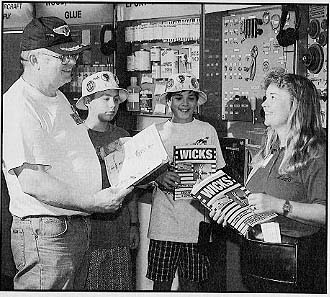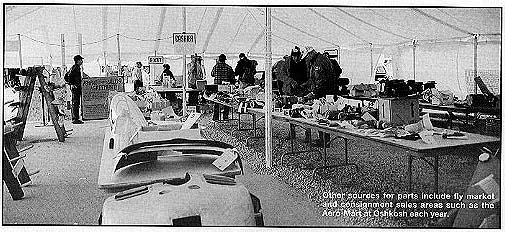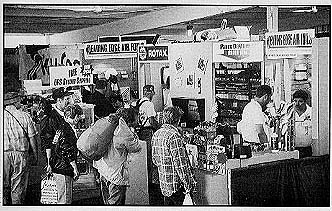

It seems like one of the many advantages to growing older is we storehouse knowledge through experience. There, does that sound profound enough for you? And, no, that's not a rationalization for turning gray. Actually, that's just another way of saying the longer we do things, the easier it becomes to find the stuff we need to do those things. Whether it is building airplanes or waterproofing the basement, the longer you're in the game the easier it becomes to find the right stuff.
Actually, when it comes to building airplanes, finding the right stuff has never been easier. Gone are the days, when we descended on derelict bamboo bombers, hacksaw and ratchet in hand. Gone are the days, when, wanting new parts, we drove ourselves crazy trying to find someone who sold Dzus fasteners, nuts and bolts or Adel clamps locally.
Now the ability to find the right part, material or tool is limited only by our willingness to recite our credit card numbers over the telephone, while reading part numbers out of a catalog.
One-stop shopping is the name of the game. One catalog, one credit card, one humungous monthly bill.
The big question is whether other ways make more sense? Does it actually make more sense, for instance, to order nuts and bolts from one supplier, while using another for tubing or resin?
The equivocal answer is yes and no.
It depends very much on what airplane is being built, what material is being used and whether it is a kit that is offered with all inclusive accessory packages.
Another question is whether there is a substantial difference from one supplier to the next for a given part or material, i.e. tubing, and is it worth the phone bill to find out?
In the first place, if the airplane is one of those totally complete kit jobs that arrives at the door as a gigantic box, complete with a huge Xacto knife and bottle of glue, a lot of the ability to shop for better parts prices is taken out of your hands.
If it is a less complete kit that lets you shop around for parts and materials, then it may make some sense to do some comparison shopping.
The farthest extreme is plans-building, where every part of the airplane has to be bought separately. Then it makes a tremendous amount of sense to shop around.
The major advantage to mail order shopping for most folks is that it is convenient. In fact, to a lot of builders the convenience of being able to make one phone call and have everything on the way, out-weighs any other factors. If that's the case, turn the page and go on to the next article, because none of the following applies directly to you.

What's Included in "Shopping Around?"
Okay, what is the definition of "shop around" and is
there a proper way to do it?
The definition of shopping around means much more than simply looking for the lowest price. If buying mail order, and that's the way most of us shop these days, there is much more than just the cost to consider. For one thing, a really inexpensive part that shows up six weeks late isn't such a good deal. The ability to actually supply the item is important.
Also, if the part being bought is something that is being manufactured as a replacement for a much more expensive AN part, i.e. a less expensive airspeed or tachometer, and it turns out to be junk, will the company stand behind it? Customer satisfaction has to be part of the equation.
There is a definite advantage to having someone answer the phone to take the order who knows what it is they are selling. The larger companies are so busy, they have to put nothing but order-takers on the phone. They know what is in the catalog and what it costs, but nothing past that. Other, smaller companies, are often staffed by homebuilders who use what they sell. However, none of that may be important. It depends very much on what is being bought. An AN-3 bolt, is an AN-3 bolt. The catalog part number says it all. But, what about aircraft grade spruce? Can the order person discuss grain lines per inch or grain run-out? If knowledge of the product is important, that also has to be part of the shopping equation.
 There
Are Different Levels of Suppliers
There
Are Different Levels of Suppliers
Right now there are three or four one-stop super-suppliers that
want to be all things to all people. In some cases, they are the
exclusive distributors for a particular series of kits, as well
as offering a wide array of everything, from bolts and nuts to
instruments and even engines. A few super-suppliers don't home
in on any particular design, but offer all the basics in materials
and components.
There is a much larger number of second level suppliers who are more generic, but still offer as wide a variety of material as possible. A few of these second level suppliers emphasise one kind of material over another. For instance, they may not carry a wide range of composite materials other than basic fiberglass, as needed for cowlings and fairings. They leave the heavy composite stuff to the kit-specialists. Or they may ignore wood entirely, leaving it to the specialists.
There is a third level of supplier that specializes in given areas or types or materials. A few of them are hardware oriented; They stock everything anyone could possibly need in nuts and bolts, nut plates, etc. A few deal in nothing but basic raw materials, such as aluminum and steel. If they offer hardware it is more as a service than anything else.
Company Size Means Little
It is nearly impossible to make accurate generalities that tie
relative cost levels to the size of the supplier, however, the
wider the range of material and the fatter the catalog, the more
overhead the supplier is carrying. They have to carry a lot in
inventory and fat catalogs aren't cheap. So, they have no choice
but to ask higher prices.
That isn't all bad, since they save phone calls and usually, repeat usually, save aggravation in the form of running around flipping over rocks looking for a supplier for the parts in question.
Unfortunately, there is no exact correlation between size of company and company satisfaction. As in all industries, there are catalog companies that purport to having everything in the world, since that is what is shown in their catalogs. In a few cases, these companies are more smoke and mirrors than substance. In others, they may attempt to inventory everything, but they understandably keep the inventories short, so they are constantly running out.
Packing lists from those companies often include a number of the dreaded "B/O" codes...back ordered. They didn't have it, so they back ordered it for you. That way they sold you the item without actually having to inventory it. Some companies have raised that kind of inventory control to a fine science and do it intentionally. Others just have trouble staying up with demand, while keeping their inventory investment low.
Either way, companies who back order as much as they ship drive homebuilders crazy. There you are, depending on the part to arrive with the other stuff so you can keep your little beauty moving forward and you get hit with a couple of "B/O" codes. Everything grinds to a halt for a while and you grind your teeth in the process.
When ordering, always get the order person's name and verify that what you are ordering is actually in stock and when it is likely to ship.
By getting the person's name it ties some responsibility to the order and gives you a person to bang on, if the order isn't right. It also makes the order person less likely to blow smoke at you, since you have their name.
Step One: Get Organized
If any of the foregoing strikes a responsive chord and you've
decided to lower parts cost while increasing service and quality,
the first step is to get organized. There are dozen's of suppliers
out there and no one of them is "best". If there was,
eventually all the rest would disappear. However, to approach
that many suppliers and see how they match your particular building
situation, you have to organize the search. It has to become a
project in itself.
It is important to determine ahead of time which suppliers you want to use for which parts, rather than waiting until the last minute. If you want until Saturday morning to find someone who supplies left handed widgets, you may find yourself backed into a corner for several weeks. It is far better to first determine who you are going to use and second, to look down the road a month or two and order far enough in advance.
Step Two: Make up a Material List
It would seem to be a logical thing for every supplier of plans
or kits to include a material list for their particular airplane.
If they did, the builder would have a ready made shopping list.
However, that not being the case, it's up to the builder to put
his own together.
Although each airplane will require a different approach, one way might be to make up a simple form that list parts by category, i.e. hardware, raw material (steel, aluminum, resin, cloth, etc.), parts (valves, bushings, etc.). Then each page of the plans is gone through, form in hand, and the material required on that page entered into the appropriate column of the form.
The final form will need a little reorganizing, when completed. It may make sense, for instance, to further break down the bolts by lengths, tubing by sizes, etc.
Assembling the material list is no-brainer work that can easily be done watching television or during some other no-stress, low activity time. It doesn't have to be done in the shop or other working environment.
Step Three: List Possible Suppliers
Each category of the material list has probably a half a dozen
different suppliers that could be called. Just go through the
list and put together as complete a list of applicable suppliers,
as possible. They will range from companies that supply nothing
but left handed, drilled, AN bolts plated with blue cadmium to
the one-stop suppliers.
Step Four: Determine Suppliers' Reputations
There are suppliers and there are suppliers. One may have great
service and lousy products, another may have great products, but
they never show up. Somewhere there is a middle ground and it
is important to determine which suppliers fall into that middle
ground by asking those who have actual experience with the companies
in question.
Call around to those who are building the same airplane you are hammering on and ask them about their experiences with suppliers. They will generally home-in on the ones who are bad, since those are the ones that stand out in their minds. Also, the only way to find out if a supplier has problems is to get burned by him. So naturally, their names would be on top the list.
It is important to dig for the suppliers' names who each builder was satisfied with. Ask what kind of products were ordered and why they were satisfied.
In effect, you'll be doing your own little market survey, which may sound like overkill, but it'll save a lot of aggravation, in the long run.
Step Five: Develop Cost Matrix
After eliminating those companies with reputations too dark to
be trusted, it is time to put together a two-dimensional matrix
that lets you comparison shop from supplier to supplier.
The material list runs down the left side of the matrix and the possible suppliers names and phone numbers run across the top. Then, it is a simple matter of calling each of the companies, giving them your material list and seeing what prices roll in. Since the prices for each item are side by side, each is a direct comparison.
Below is a sample of a matrix and the prices show are what were actually received, when each supplier was called.
Notice that, when it comes to raw material, it is always cheaper to call a company that specializes in that type of material. Most of the time these companies are smaller and have much smaller overheads. More important than that, since they specialize in specific items, i.e. 4130 and aluminum, they can buy in much larger lots so their costs are much lower, allowing them to pass those savings on to others. Also, the case of some materials, 4130 being a classic example, most of the larger companies with their fancy catalogs are buying from one of the specialty suppliers and just marking it up. That's why there is such a dramatic difference.
The ability to buy in large quantities is one reason some of the one-stop companies can outsell the smaller and 2nd level companies in some areas.
Material Supplier "A" Supplier "B"
Supplier "C"
Large, one-stop co. 2nd level co. Specialty co.
Tubing-50', 3/4 x .035 $90 $117.50 $59.50
45º ply, 4' x 8', 3/32 $212 N/A N/A
Aluminum, 4 x 8, .025 $80.46 $97.28 $58.80
Bolts, 50, AN-7 $20 $17 $12.50
The bottom line is, it is difficult to predict prices from one supplier to the next, so, if convenience isn't at the top of your shopping list, it always pays to shop around. BD